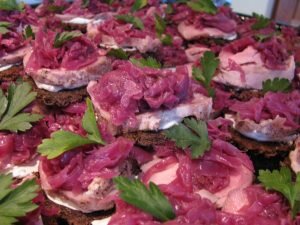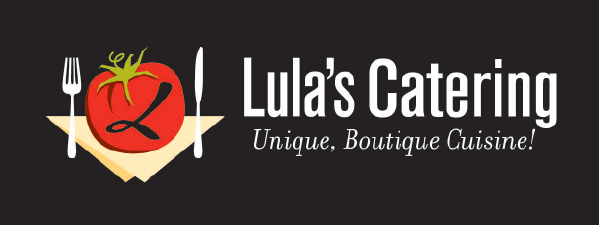Happy Valentine's Day! Is Cabbage the New Kale?
 Happy Valentine's Day!Cabbage's reputation has been transformed from peasant fare to superfood. It's the new kale. With the "fermentation rage" going on, I thought it might be a great time to prime you on the varieties of cabbage.If you believe everything you read about the health benefits of this brassica, you should be eating it every day. For a start, it's high in vitamins A, B, C and K, full of fiber, iron and potassium and said to have cancer-preventing benefits. If that isn't enough, it ranks as the vegetable with the fewest amount of calories or fat (at a mere 25 calories per 3.5 ounces.) Oh, and it's cheap.Cabbage is extremely versatile. You can use it in stir fries, sautés and braises, with meat, poultry, fish or all on its own — think corned beef, sauerkraut, kimchi, coleslaw, soups, braises, raw, pickled and more. You can find Lula's tasty, beautiful appetizer (above) Brown Sugar Rubbed Pork Loin on Black Bread with Braised Cabbage and Apples here. You can stuff cabbage leaves or use them raw as a natural container for sautéed vegetables or meat.
Happy Valentine's Day!Cabbage's reputation has been transformed from peasant fare to superfood. It's the new kale. With the "fermentation rage" going on, I thought it might be a great time to prime you on the varieties of cabbage.If you believe everything you read about the health benefits of this brassica, you should be eating it every day. For a start, it's high in vitamins A, B, C and K, full of fiber, iron and potassium and said to have cancer-preventing benefits. If that isn't enough, it ranks as the vegetable with the fewest amount of calories or fat (at a mere 25 calories per 3.5 ounces.) Oh, and it's cheap.Cabbage is extremely versatile. You can use it in stir fries, sautés and braises, with meat, poultry, fish or all on its own — think corned beef, sauerkraut, kimchi, coleslaw, soups, braises, raw, pickled and more. You can find Lula's tasty, beautiful appetizer (above) Brown Sugar Rubbed Pork Loin on Black Bread with Braised Cabbage and Apples here. You can stuff cabbage leaves or use them raw as a natural container for sautéed vegetables or meat.
Cabbage Varieties To Know
Green Cabbage - Green cabbage is the most basic and common of cabbages. Use it in salads and slaws, stir-fry it, or slow-cook it in soups and stews to bring out its essential sweet nature. Look for heads that feel heavy for their size (which can range from softball to almost basketball size,) with tightly packed, moist looking leaves. Green cabbage can be used raw in slaws and salads and holds up to all kinds of assertive, strong flavors.Red Cabbage - Red cabbage looks like green cabbage except, well, it's red. Red cabbage heads tend to be a bit smaller than the green ones but look for tightly packed, moist-looking leaves and heads that feel heavy. Red cabbage is delicious thinly sliced in salads like slaws or can easily be cooked. The rich color of red cabbage offers a concentration of anthocyanin polyphenols, as well as antioxidants and contain anti-inflammatory properties.The only downside to red cabbage is that it can turns an odd blue color when cooked. Add vinegar or a touch of lemon juice when cooking to avoid blue food!Savoy Cabbage - Savoy cabbage is also known as curly cabbage. With ruffled, lacy, deeply ridged leaves, these cabbages are gorgeous and tasty. The tender leaves tend to be more loosely layered and less tightly packed than green or red cabbage, although it can be used in much the same way — raw in salads, stir-fried, braised or added to soups and stews. Because the leaves are so tender you can use this cabbage a wrap for rice dishes or stir fried meat.Napa Cabbage - Napa cabbage, also called Chinese cabbage or celery cabbage, has a different look than other cabbages. It has long light-green leaves and white stalks that appears more lettuce-like with a mild flavor that has a bit of a spicy, almost peppery kick at the end. Great for pickles, kimchi, stir fries and salads.Bok Choy - Bok choy has a mild flavor most often used in stir fries, but is delicious braised and used in simple preparations. The cabbage flavor is subtle.No matter what type you buy, look for cabbage heads that are firm, shiny, feel heavy for their size and, except for Napa cabbage, have tightly packed leaves. While you don't want bruised or beaten-up vegetables, you can peel off and discard the outer leaves, so they need not be pristine.Cabbage will keep best refrigerated, and will last several weeks. If you insert cabbage into your diet on a regular basis, the "rumble in your tummy" will dissipate in only a few days and the nutrition is worth it!
A Note From Chef Lori
 A Valentine's (or any other amour) appetizer - our Heart's Afire 5-Spice Quail Breast in Puff Pastry with Wilted Winter Greens and Apricot Mustard.Click here to visit our website!
A Valentine's (or any other amour) appetizer - our Heart's Afire 5-Spice Quail Breast in Puff Pastry with Wilted Winter Greens and Apricot Mustard.Click here to visit our website!
